Menu
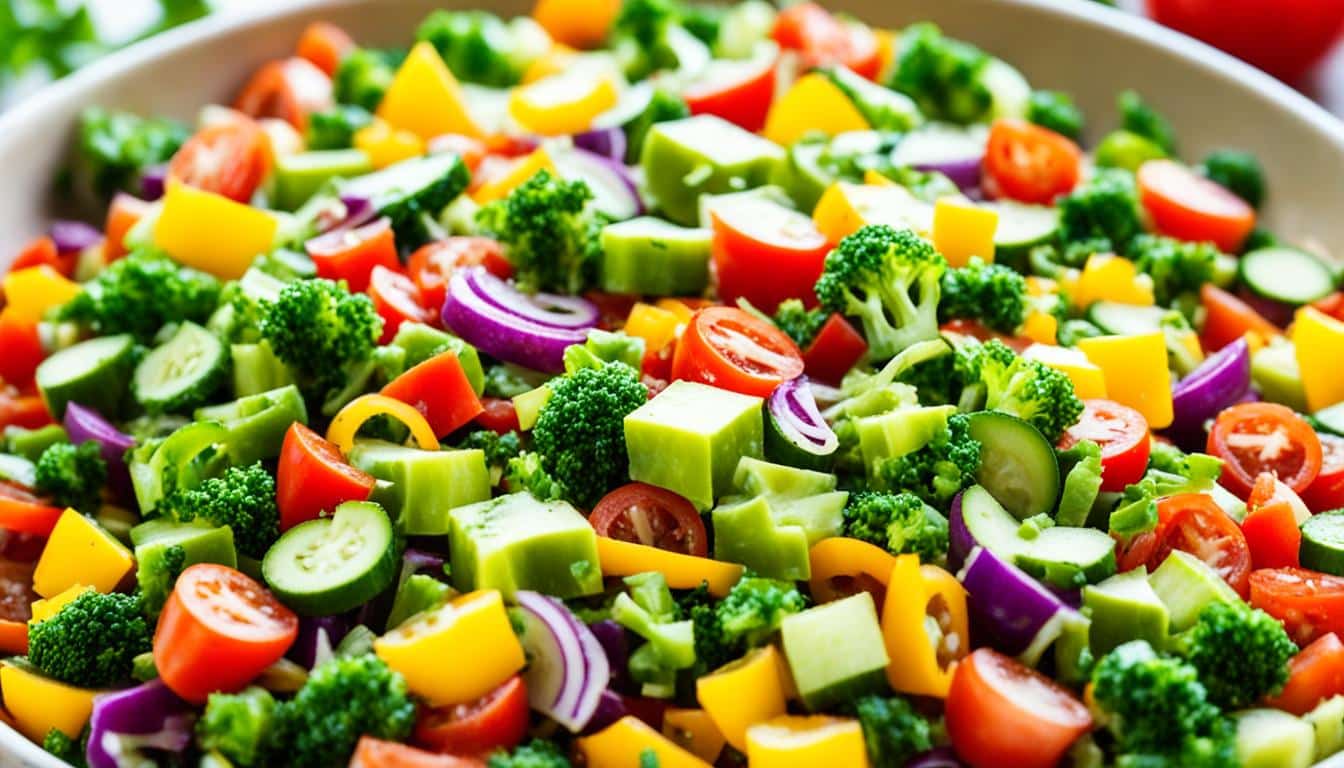
Every year, an average American family throws away about $2,000 in food. This big number shows us we need to change how we deal with leftovers. By reusing these scraps, we can help the Earth and spend less on food.
Bruised fruit is perfect for baking and smoothies. Vegetable scraps and even stale bread can turn into tasty stocks or morning delights like French toast. There’s so much we can do with leftovers, making them into delicious dishes. This way, we cut down on waste and make our meals more exciting and diverse.
Leftover products are more than just about saving money. It’s recognising that each piece of food still has its value. You can turn a tired veg into a stir-fry or use it to add taste to soups. This smart use of leftovers cuts down on waste, a big issue in food production.
Having set recipes can really help use up leftover food. It makes cooking consistently good meals easier. This is key for restaurant kitchens and also helps keep costs down. Using a method like the conversion factor helps chefs adjust recipes perfectly. This method is a way to multiply ingredient amounts accurately. So, whether it’s using Baker’s percentage or another method, it ensures recipes come out just right every time.
Getting the portions right in recipes is critical. It keeps costs under control and boosts profits. By using exact recipe amounts, chefs avoid making too much food. This precision saves ingredients and money. For dishes using leftover veg, careful portion control is vital. It ensures the recipe turns out perfectly, whether you’re measuring in cups or grams.
Using leftovers well is important for many reasons. It fights food waste and makes cooking more enjoyable. With a bit of creativity, we can turn these leftovers into something great. This way, we enjoy our meals more and do our part for the planet.
Fruits not perfect for eating raw can still be turned into great dishes. This helps us use extra fruits and cut down on waste. Here are some smart ways to use these fruits and veggies.
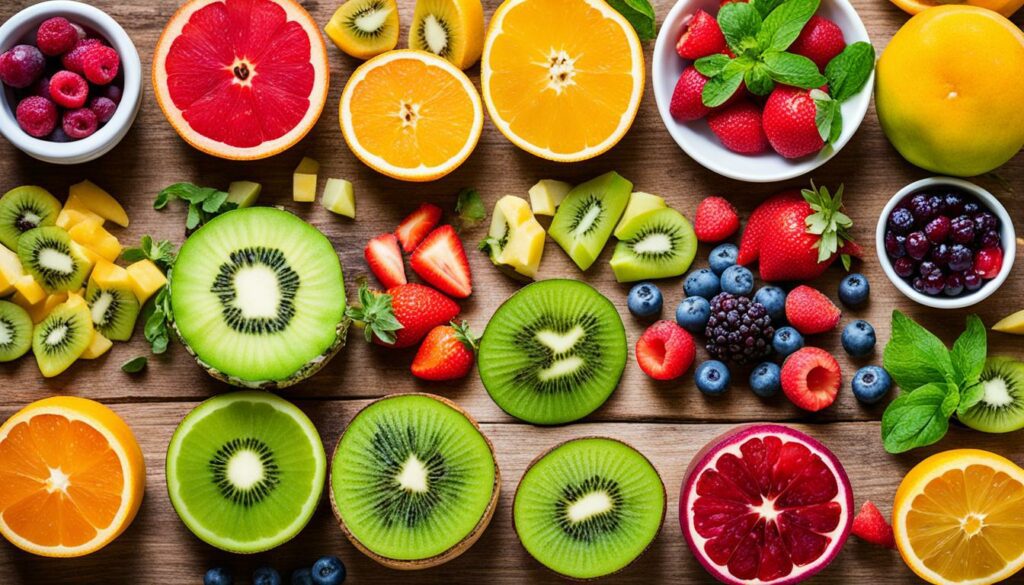
Smoothies and juices are easy and tasty ways to use up these fruits. Nearly spoiled bananas, strawberries, or peaches can make your smoothie wonderful. Pineapples, melons, even wilted greens work well in juices. And, adding a bit of lemon can adjust the sweetness.
Baking is great for turning overripe fruits into treats. Bananas make delicious bread, while apples and pears work well in crisps. Peaches without their tang are perfect for jams or pastries. Overripe cantaloupe can be used for a sweet condiment, just add lemon juice to cut through.
Making jams can keep fruits fresh and tasty for longer. Overripe berries are ideal for making jams. They can also be used for jellies and ice cream. For citrus about to spoil, turn them into marmalade for an extra two weeks of use.
To provide a clearer picture, here’s a comparative table of different uses for overripe fruits:
| Fruit | Usage | Extended Shelf Life |
|---|---|---|
| Citrus Fruits | Marmalade | Two weeks |
| Peaches/Nectarines | Jams | Over a month |
| Cantaloupe | Condiment like apple butter | Several weeks |
| Berries | Jam, Ice Cream Base | Over a month |
| Bananas | Smoothies, Baking, Banana Ketchup | Varies |
Embracing leftover produce is key to culinary innovation. It opens the door to a range of dishes that boost flavour and are good for the planet. Don’t forget the power of diverse fruits and veg in leftover produce recipes.
For example, mashed bananas or applesauce can stand in for half the butter in baked treats. This adds a natural sweet touch and keeps them moist.
“Repurposing leftover vegetables like mashed butternut squash can enrich dishes by thickening textures, offering a unique twist on traditional recipes.”
Keeping leftovers fresh by freezing them when they’re at their best means you can enjoy them later. This simple step cuts down on food waste at home, letting you enjoy out of season fruits in your smoothies.
Start a list for leftover ingredient recipe inspiration. It can be a game changer. Think frittatas for clearing out the veg drawer or sauces made from extra fruits, like applesauce and pear sauce.
Make something different by mixing up grated root veg into cakes, then fry or bake them. They’re a great way to use up several leftovers and are tasty, too. And for dessert, try adding fruits and veg to your sweet treats for a healthier choice.
Roasting root veg and topping them with green sauces is also smart. These sauces use up greens that might not last much longer. And starting a compost helps make the most of any leftover produce.
About 50% of produce is wasted yearly, reports The Guardian. Most of this waste ends up in landfills, as the EPA notes. Companies like Imperfect Produce offer a solution by delivering affordable, ‘ugly’ yet tasty fruit and veg to homes.
With these leftover produce recipes, your culinary creativity can soar. From juices with fruits to stews with veg, there’s so much you can do. Make the most of every bit of your produce.
Stale bread can be a key ingredient in many dishes. It doesn’t need to be thrown away. It can bring new textures and flavours to your meals. This is great for breakfast and any big meals. It’s really versatile and important in cooking with leftover veg and produce.
French toast made from stale bread is yummy and easy to do. French toast casseroles are a good example, where the old bread makes it soft and rich. Each part of the United States has special ways of making French toast. If you like savoury more than sweet, try making croutons instead. They’re great on salads and soup. Making them at home is cheap and easy.
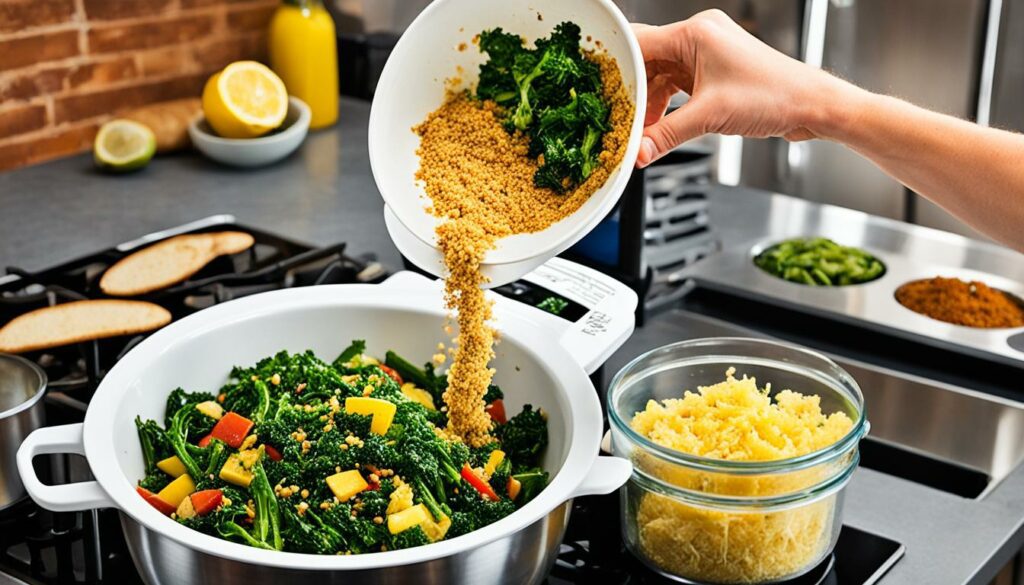
If you have a KitchenAid® Food Grinder Attachment1 or a food processor, turning bread into crumbs is easy. Just pulse the bread to the size you want and then bake them at 300°F. These breadcrumbs keep well and can be used in lots of meals, like meatballs. And don’t forget about stuffing. Using old bread in stuffing can make holiday dinners more special. Add some fresh fruits and vegetables to your stuffing for a tasty change.
| Dish | Region | Cost per Serving | Cooking Technique |
|---|---|---|---|
| French Toast Casserole | Minnesota | Varies | Baking |
| Bread Pudding | California | Varies | Baking |
| Homemade Croutons | New Jersey | $0.04 | Baking |
For nearly a decade, I’ve not bought vegetable broth. Instead, I make it from leftover peels and scraps. This shows a creative ways to use leftover produce. Since 2014, my blog has shared healthy recipes for surplus vegetables. I’m passionate about sustainable cooking.
Homemade veggie broth has many uses. It can enhance soups, stews, dal, and stir-fry sauces. It also adds flavour to rice dishes, pot pies, and gravies.
Freezing extra broth keeps it ready for use. A good idea is to freeze it in ice cube trays. This makes it easy to use just the right amount. It keeps the broth healthy too, as it preserves its nutrients.
A store-bought veggie broth costs about $5. Yet, making it from kitchen scraps is almost free. You can use various scraps like allium skins, corn cobs, and root vegetable peels. Just avoid some like cabbage and Brussels sprouts as they might make the stock bitter.
You can also add chicken bones to make a richer broth. This method takes longer, about 6 to 8 hours, but the flavour is much deeper. It’s a great way to cook more sustainably.
Making stock is easy. Just simmer vegetable scraps in water, adding bones if you like, for 30-45, or more, hours. The broth lasts a week in the fridge and months in the freezer. It’s a sustainable cooking method for any time of the year.
In summary, making broth from veggie scraps is smart. It adds flavour, lowers waste, and embraces an eco-friendly lifestyle. This shows creative ways to use leftover produce and leads to healthier, greener cooking habits.
Nutritious soups and broths are a great way to use up bones and veggie scraps. Around 31.9% of food in the US homes goes to waste, hurting the planet. Food waste in landfills creates methane, which is worse for global warming than CO2.
Project Drawdown says that cutting food waste is key to fighting climate change.
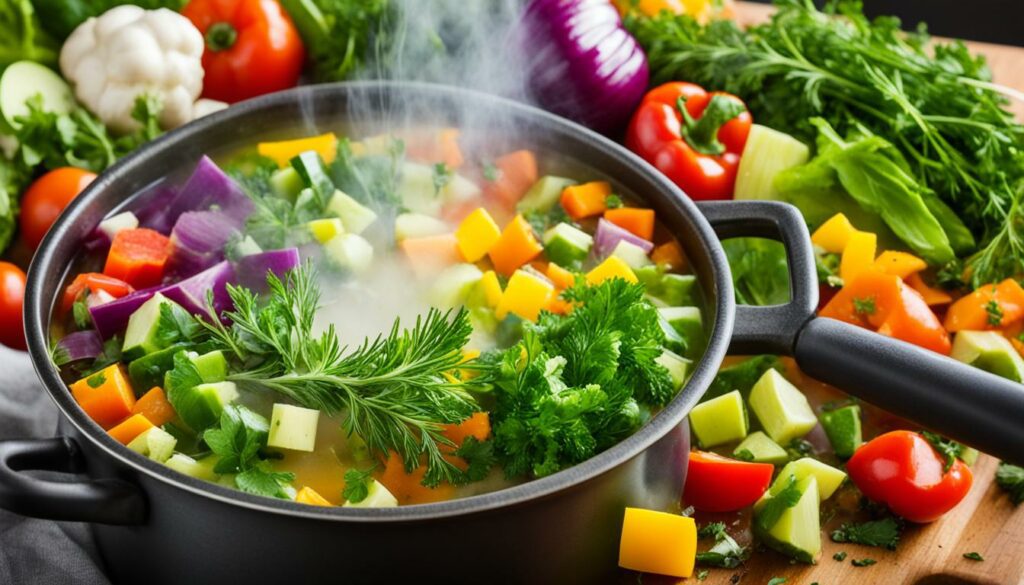
Turning leftover produce into yummy meals is easy. I’ve seen people make great soups from veggies, adding herbs and mushrooms. You can also use cheese rinds and grains to make your soups even more delicious.
Freezing broth is smart for keeping a quick soup base. Vegetable soup, for instance, can be good for four days in the fridge or up to three months frozen. Use airtight containers to keep the taste fresh.
This also helps with meal planning, making your dishes more varied.
Making broths from bones and veggies is simple. It’s a good way to make food that’s good for you. A basic bone broth recipe creates 8 cups, boiling bones and veggies. You can do the same with veggie scraps, adding acidic things like vinegar for flavour.
These homemade broths are good for you and the planet. Vegetable soup gives you 137 calories and lots of fibre, a healthy choice. It also has protein, perfect for a balanced diet and the environment.
So, making these soups is a win for your health and the Earth. It’s a simple and tasty way to make a difference
When you’re short on time and the fridge is full of food, quick leftover produce meal ideas are a lifesaver. We’ll look at ways to turn simple ingredients into tasty dishes and reduce waste.
Start with meats like beef and chicken, perfect for meals you can quickly reheat. Opt for classics like beef stir-fry or chicken salad to create delicious, quick dishes. Include healthy choices to make sure your meals keep you full and happy.
Different meals need different times to cook. Some dishes are ready in 30 minutes, while others take longer. You can use ingredients like cauliflower, chickpeas, sweet potatoes, tomatillos, tofu, or lamb meatballs to add variety to your meals.
If you’re looking for easy leftover veg recipes, try healthy swaps like light sour cream or brown rice. You can also add simple extras like broccoli, a green salad, or rice noodles. This turns your leftovers into complete, tasty dishes.
There are many ways to reinvent leftovers into new, quick dishes. Whether you follow a vegan, diabetic, or gluten-free diet, these recipes can suit your needs. Use different cooking styles such as skillets, slow-cookers, ovens, or crockpots to cook. There’s a method for everyone’s taste.
| Protein | Vegetable | Method |
|---|---|---|
| Chicken | Cauliflower | Skillet |
| Beef | Chickpeas | Oven |
| Tofu | Sweet Potatoes | Slow-Cooker |
Don’t forget about storing leftovers in the freezer for future meals. These quick leftover produce meal ideas make sure every item in your fridge sees its full potential. They help you eat well, save money, and cut down on waste effortlessly.
It’s great to see readers excited about sharing their recipes for extra vegetables. The creativity shown in turning simple veggies into tasty meals is fantastic.
Readers love trying new things with vegetables like peas, broccoli, and bell peppers. They enjoy dishes such as vegan mac and cheese and brown rice risotto that work well for vegans but also allow for changes in ingredients.
One dish that everyone seemed to love was broccoli almond pizza. People added their own twists, like olives and shiitake mushrooms, making it even tastier. This shows we can turn leftover veggies into something amazing.
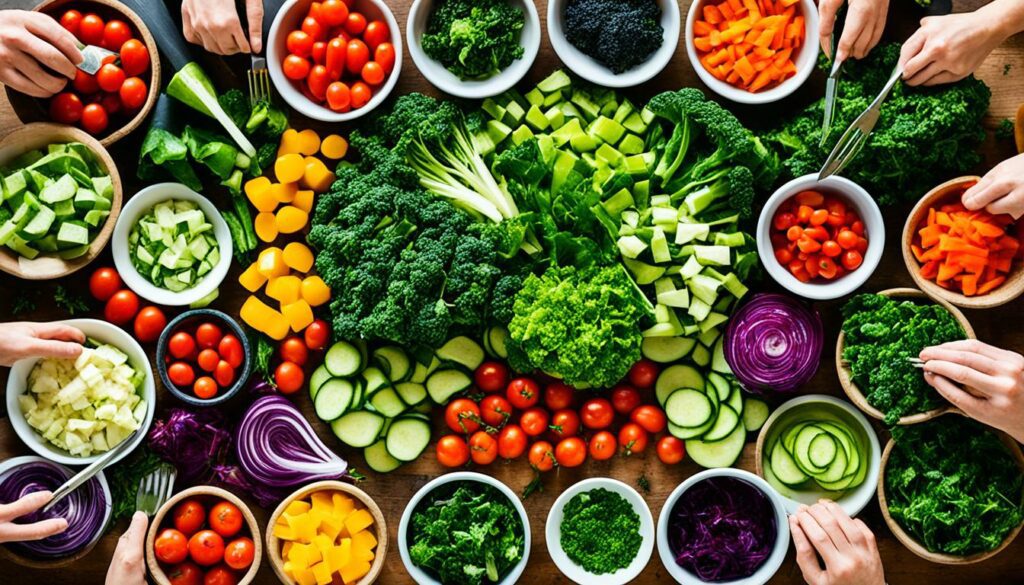
Many readers changed the recipes to fit what they had or liked. For example, using kale instead of spinach. This shows how flexible vegetables are in many recipes like roast carrot salad or veg miso soup.
These recipes not only help reduce waste but are also healthy. The veg miso soup, for example, is full of flavour yet light on calories.
| Original Ingredient | Substitute Ingredient | Recipe Inclusion |
|---|---|---|
| Spinach | Kale | Vegan Mac and Cheese |
| Dill | Cilantro | Cauliflower Carbonara |
| Butternut Squash | Sweet Potato | Spiced Roast Carrot Salad |
Readers are very thankful for ideas on using up extra veggies smartly. Recipes like carrot top pesto and courgette soufflé omelette are a hit for managing excess produce.
These recipes show that with a bit of creativity, surplus vegetables can be turned into great dishes. There’s a variety, from courgette fritters to carrot falafel. Even desserts like roasted banana ice cream are great for using up too-ripe fruits.
Salads are brilliant for using up leftover produce. They need little effort but bring big satisfaction. By mixing veggies or adding fruits, a simple salad can become a great meal. Using leftovers guarantees nothing goes to waste and you get to enjoy a healthy treat.
Creating mixed veggie salads is a top pick. I love checking out local markets for fresh produce. A mix of seasonal veggies with grains and nuts turns leftovers into a tasty dish. Here’s an idea:
Fruit salads are a fun way to use up leftovers. They add sweetness and beauty to your meal. Try these:
I also enjoy meals inspired by my travels. Exploring food scenes in places like New York City enriched my cooking journey. It helped me start a community kitchen in Sydney. There, we made hearty salads from leftovers, celebrating sharing and health.
Getting creative with leftovers saves money and makes meals better. Maybe it’ll even lead to your new favourite dish.
| Leftover Ingredient | Repurposed Salad Idea |
|---|---|
| Cucumbers, Red Pepper, Romaine Lettuce | Mix with Olive Oil, Lime, Fresh Basil, and Sunflower Seeds |
| Strawberries, Grapes | Add to Veggie Mix for Fruit-Infused Salad |
| Sunflower Seeds, Fresh Basil | Top Mixed Veggie Salad for Extra Flavour |
Making casseroles with leftovers is a top choice. It allows you to mix different leftover foods into one dish. This way, you get a tasty and filling meal from odds and ends. It’s easy and smart to turn what’s left in the fridge into dinner.
Start by picking about 48 ounces (3 pounds, nearly 9 cups) of frozen veg, like broccoli and carrots. This is perfect for making a batch that serves about 12. This guarantees enough food for your family. Any leftovers can be kept in the fridge for up to four days, making more meals later.
With casseroles, you have lots of room to change the recipe to what you like. Try adding green beans, zucchini, or spices like paprika for variety. You can swap the cheese for something else too, like cheddar or homemade cheese sauce, to suit your taste.
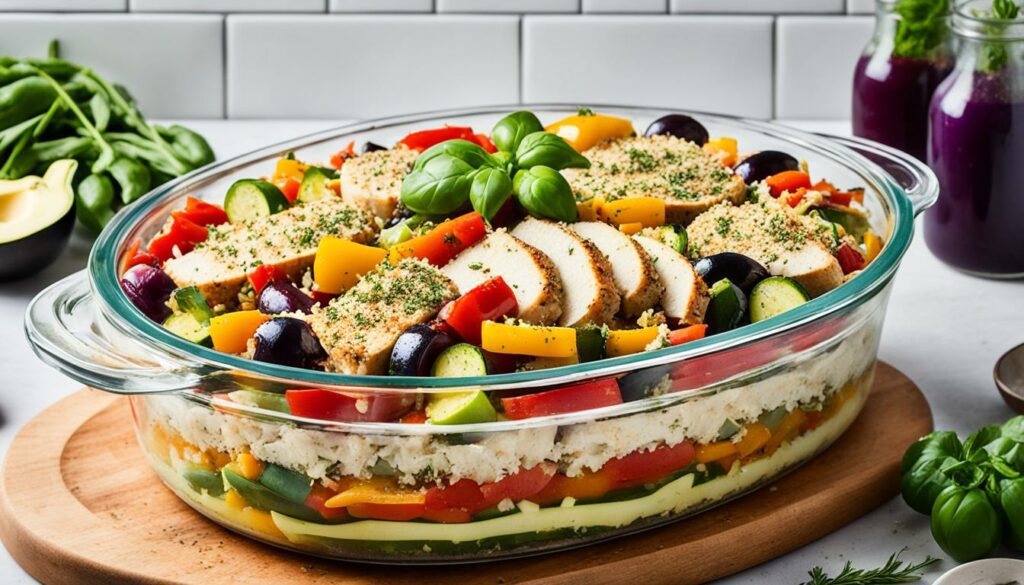
Are you after easy leftover veg recipes? Think about diet needs. To go gluten-free, use crumbs made from gluten-free bread or add nuts instead. You can make the casserole a day early, keeping it in the fridge until it’s time to cook.
Now, on to cooking. Start by microwaving the veg until they soften. Then mix them with your chosen add-ins and put them in a baking dish. Let it bake in a 350-degree Fahrenheit oven for 30 to 45 minutes. You’ll know it’s ready when the top is nice and brown.
| Ingredient | Substitutes |
|---|---|
| Frozen Vegetables | Fresh Vegetables, Different Varieties |
| Velveeta Cheese | Cheddar, Parmesan, Feta, Ricotta, Homemade Sauce |
| Bread Crumbs | Gluten-Free Bread Crumbs, Chopped Nuts (Pecans, Walnuts, Cashews) |
| Baking Dish | Aluminum Foil Pan |
Using leftovers in casseroles can spice up your meals and cut down on waste. This way, you get more out of what you have. Plus, it’s a fun way to try new things in the kitchen.
More people are now finding ways to use up leftover fruits and vegetables instead of throwing them away. In the United States, 40% of wasted food comes from these items. It shows that we need to be more creative with how we use them. A great way is to use leftover fruit in sweet treats like pies and crumbles. This way, we enjoy the fruits before they go off.
There are also savoury options like vegetable stir-fries that are great for using up extra veggies. Stir-fries are flexible, letting you mix different vegetables like asparagus, bell pepper, and broccoli in one tasty meal. Smoothies and salads are also popular choices for using up produce. They are quick and easy, fitting well with our busy lives.
| Strategy | Benefit |
|---|---|
| Fruit-Infused Water | Minimal effort way to utilize excess fruit |
| Juicing | Popular method within the health community |
| Casseroles | Convenient meal preparation |
Fruit-infused water is easy to make and a healthy choice. It’s also good for saving money. Using up leftovers can save a family around $1,500 each year. This shows that using every bit of our food is good for our wallets and the planet. Plus, it adds variety to our meals.
Cooking with what’s left helps us be less wasteful and enjoy different foods. Making a pie out of bruised apples or a stir-fry out of leftover veggies is fun and good for the Earth. Every meal we create from leftovers is a step towards sustainable eating.
Freezing food is a top way to keep it fresh for longer. It also helps with meal prep later on. By learning to freeze right, you cut down on food waste. Let’s look at some tips for freezing, especially with extras, and easy ways to use them.
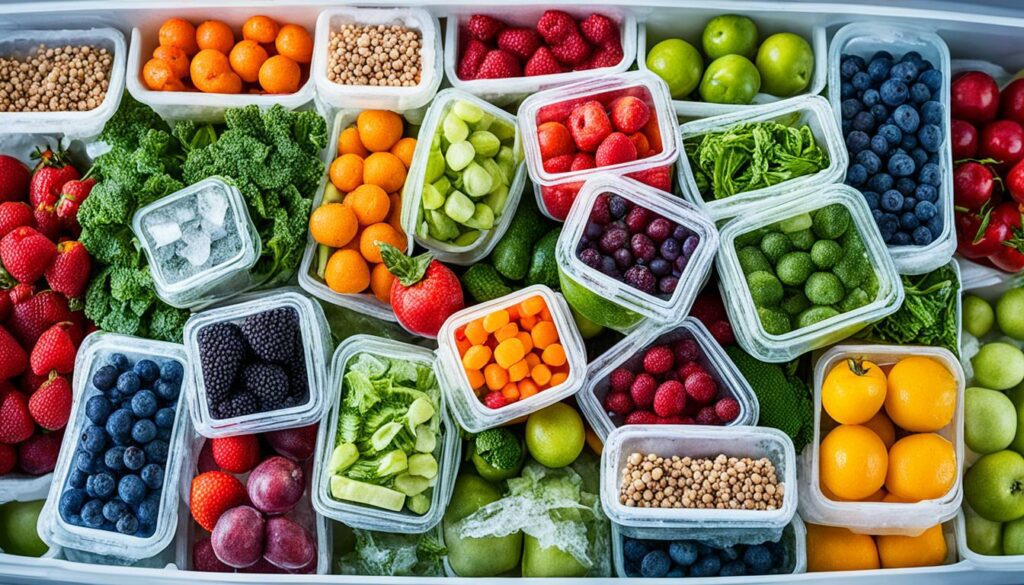
Some foods fare better in the freezer than others. Knowing what freezes well can save you from throwing away food. Here’s a list of foods that freeze well:
Having the right freezing methods helps keep your food as good as fresh. Below are ways to freeze and defrost leftovers properly:
Knowing these freezing methods lets you keep your food fresh. It’s great for trying out new recipes with your leftover produce. Plus, it fits perfectly into everyday cooking with simple leftover veg dishes.
| Preservation Method | Description | Best Used For |
|---|---|---|
| Dehydration | Removes moisture using a dehydrator, extending shelf life substantially. | Fruits, Vegetables, Herbs |
| Freezing | Freezes fresh produce at peak freshness for later use. | All types of foods |
| Pickling | Uses vinegar or brine in mason jars to preserve items. | Fruits, Vegetables |
| Fermentation | Alters colour, flavour, and texture through controlled microbial growth. | Vegetables, Dairy |
Transforming leftovers opens up many options, especially for stir fry. It’s easy to make and covers various leftover foods, making a fast and tasty meal. Tossing vegetables in oil at high heat is perfect for healthy eaters who enjoy using up extra veggies.
“On average, leftovers should be used within two to three days to ensure maximum freshness and safety.” Stir-frying is a smart way to use them up, keeping food tasty and healthy.
Mixing leftover pasta and veggies into stir fry is a great idea. Pasta needs refrigerating after 5 days. Once pasta sauce is open, it’s good for 7 days. This meal blends vitamins, carbs, and proteins into a flavoursome dish.
Frozen leftovers utilisation rate is key. Freezing extra vegetables extends their use and cuts waste. Stir-fries are perfect for this, offering healthy and quick meals anytime.
Other than stir fry, there are many creative ways to use leftovers. Making pancakes from mashed potatoes is a fun and tasty example. It shows how we’re trying to cut down on food waste and use up everything.
Knowing how to safely use leftovers can turn them into exciting new meals. Use these ideas to make eating healthy, fun, and waste-free.
Exploring creative ways to use leftover produce has many benefits. It helps the environment and your wallet. In the United States, a lot of food goes to waste. About 30 to 40 percent of all food is never eaten. Imagine, the average home throws away £1,500 worth of food a year. And restaurants toss out half a pound of food with each meal.
Using creative methods, we can cut down on the 290 pounds of food each person wastes annually. This can greatly change how we think about food. Food waste at home makes up nearly a fifth of all food produced. This waste equals about one percent of what the US makes each year. Young people, like Generation Z, show great promise in fighting against food waste.
Food waste has global impacts. Research in Denmark, Croatia, and parts of Europe shows different ways to cut back. Solving food waste with new recipes isn’t just a fad. It’s a strong tool for a better, more sustainable world. These recipes can make our meals more interesting and help the planet at the same time.
Got leftover veggies or fruits? Make stir-fries, soups, or casseroles to mix them up. You can also try tossing them into smoothies. For fruits, use them in pies or make jams. For veggie scraps, consider using them in stocks or in a compost.
Need a quick meal with leftovers? Think about tossing them in salads or stir-fries. Or blend them into smoothies. Even simple sandwiches can be a tasty, fast option.
Surplus veggies can turn into great meals. Try making vegetable soups or roasted trays. You could also do casseroles or fresh salads.
For a twist, whip up veggie-packed stir-fries. Or, bake them into quiches and tarts for something different.
Don’t toss overripe fruits! Blend them into smoothies. Or juice them for a drink. You can also bake them into cakes, muffins, or make jams.
These ideas help to avoid food waste and give you sweet treats.
Stale bread is great for certain recipes. Try French toast or make croutons. It’s also perfect for breadcrumbs or as stuffing.
Bread pudding is another tasty way to prevent waste. It adds new life to old bread.
Vegetable scraps are more useful than you might think. Boil them to make stocks or broths. Or, toss them into compost.
Don’t forget, they can spice up meals like stir-fries. This way, everything gets used.
To make your soups and broths hearty, use leftover bones. Add in vegetable scraps too. Freeze extra broth to use later.
Both bone broth and veggie stock add great flavours to many dishes.
Have extra veggies? Bake them into casseroles or make soups. They’re also perfect for fresh salads.
Another idea is to infuse water with your vegetables. This adds nutrients to your daily meals, cutting down on waste.
Leftover produce is perfect for salads. Mix them up for a nutritious meal. They add a burst of freshness to your plate.
Got bits of this and that? Throw them into a casserole for an easy dinner. It uses up leftovers and is great for sharing or saving for later.
Try out fruit pies or veggie stir-fries with your leftovers. Fruit crumbles are another tasty option. For something different, bake veggie-filled quiches.
These dishes make sure nothing goes to waste, while keeping your meals interesting.
Freezing food keeps them fresh for a long time. Know which kinds freeze well and how to freeze properly. This helps with food prep and cuts down on wasted food.
Have leftovers? Mix them up and turn them into a stir-fry. Use various veggies, proteins, and grains. It’s a tasty way to make a new meal from what you have.